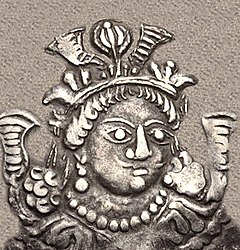Kidara I
| Kidara | |
|---|---|
 Portrait of Kidarite king Kidara I, circa 350-386 CE.[1] He wears his characteristic crown with ribbon flying upward. The use of the 3/4 portrait is sometimes attributed to the influence of the coinage of Byzantine ruler Arcadius (377–408 CE).[2] | |
| Kidarites | |
| Reign | c. 350–390 CE |
| Predecessor | Peroz |
| Successor | Uncertain |
"Kushan" coins of Kidara
The word "Kushana" in Brahmi script (

 Ku-shā-ṇa) as it appeared on the bottom left corner of Kidarite coins circa 350 CE.[3]
Ku-shā-ṇa) as it appeared on the bottom left corner of Kidarite coins circa 350 CE.[3]
Kidara I (Late
Reign
Kidara himself was a nomadic ruler who invaded the areas of
Sogdiana and Bactria from the north circa 300 CE.[5] His people may have been pushed out from the northern areas of Bactria by migrating Hephthalites.[4]
Kidara's ethnicity is unclear, but he may himself have been a
Kushans.[5]
Kidara having established himself in Tukharistan and Gandara, took the title of
Kushans, possibly due to their ethnic proximity.[5]
Coinage
Kidara struck both Sasanian-style gold and silver coins (imitating his immediate predecessor in the region
-
Coin in the name of Kushano-Sasaniantamghamint.
 to the right. Balkh
to the right. Balkh -
Coin in the name of Kidara, with legend "βαγο Κιδαρο οοζορκο κοþανοþαο" "Kidara, the great Kushanshah". Type 6A-D. Coin type found in Tepe Maranjan, dated to before 388 CE.[8]
-
Kidara facing, with a legend in his own name.Kushanaking".
See also
- Kushano-Sassanians
- Sasanian coinage of Sindh
References
- ^ CNG Coins
- ^ Lerner, Judith A. (210). Observations on the Typology and Style of Seals and Sealings from Bactria and the Indo-Iranian Borderlands, in Coins, Art and Chronology II. The First Millennium CE in the Indo-Iranian Borderlands. Vienna: ÖAW. p. 246, note 7.
- ^ Tandon, Pankaj (2009). "An Important New Copper Coin of Gadahara". Journal of the Oriental Numismatic Society (200): 19.
- ^ Unesco p.38 sq
- ^ Unesco p.119 sq
- ISBN 0-87341-753-4.
- ISBN 978-3-7001-6885-0.
- ^ Bakker, Hans T. (2017). The Huns in Central and South Asia. How Two Centuries of War against Nomadic Invaders from the Steps are Concluded by a Game of Chess between the Kings of India and Iran.
- ^ "Kushano-Sasanian Kings of India. "Bahram" (Kidara)". CNG Coins.



![Coin in the name of Kidara, with legend "βαγο Κιδαρο οοζορκο κοþανοþαο" "Kidara, the great Kushanshah". Type 6A-D. Coin type found in Tepe Maranjan, dated to before 388 CE.[8]](http://upload.wikimedia.org/wikipedia/commons/thumb/4/41/Kidara_coin%2C_4th_century_CE%2C_type_6A-D.jpg/200px-Kidara_coin%2C_4th_century_CE%2C_type_6A-D.jpg)
![A coin of Kidara in the style of Indo-Sassanian ruler Bahram Kushanshah.[9] Crown with ribbon flying upward. Gandhara mint.](http://upload.wikimedia.org/wikipedia/commons/thumb/f/f7/Kidarites_ruler_Kidara_circa_350-385_CE_in_Sasanian_style.jpg/200px-Kidarites_ruler_Kidara_circa_350-385_CE_in_Sasanian_style.jpg)
